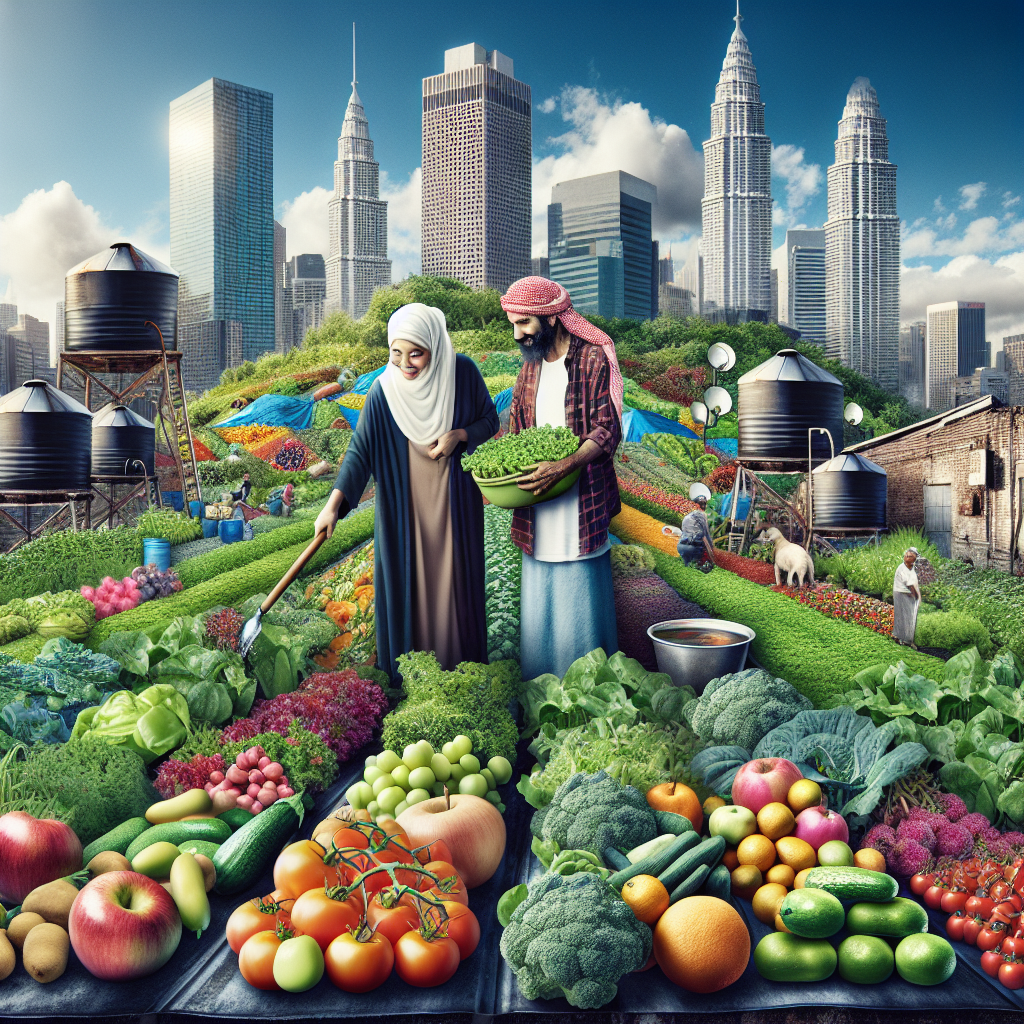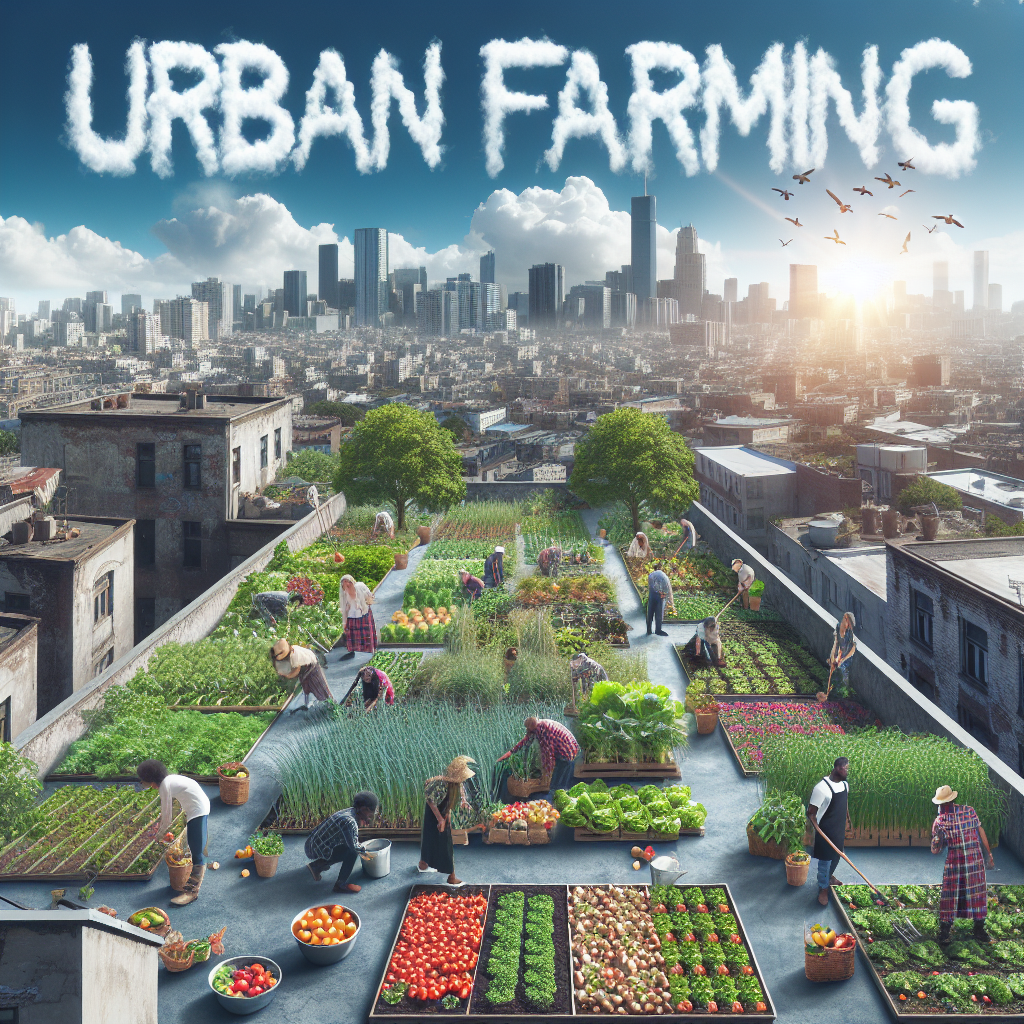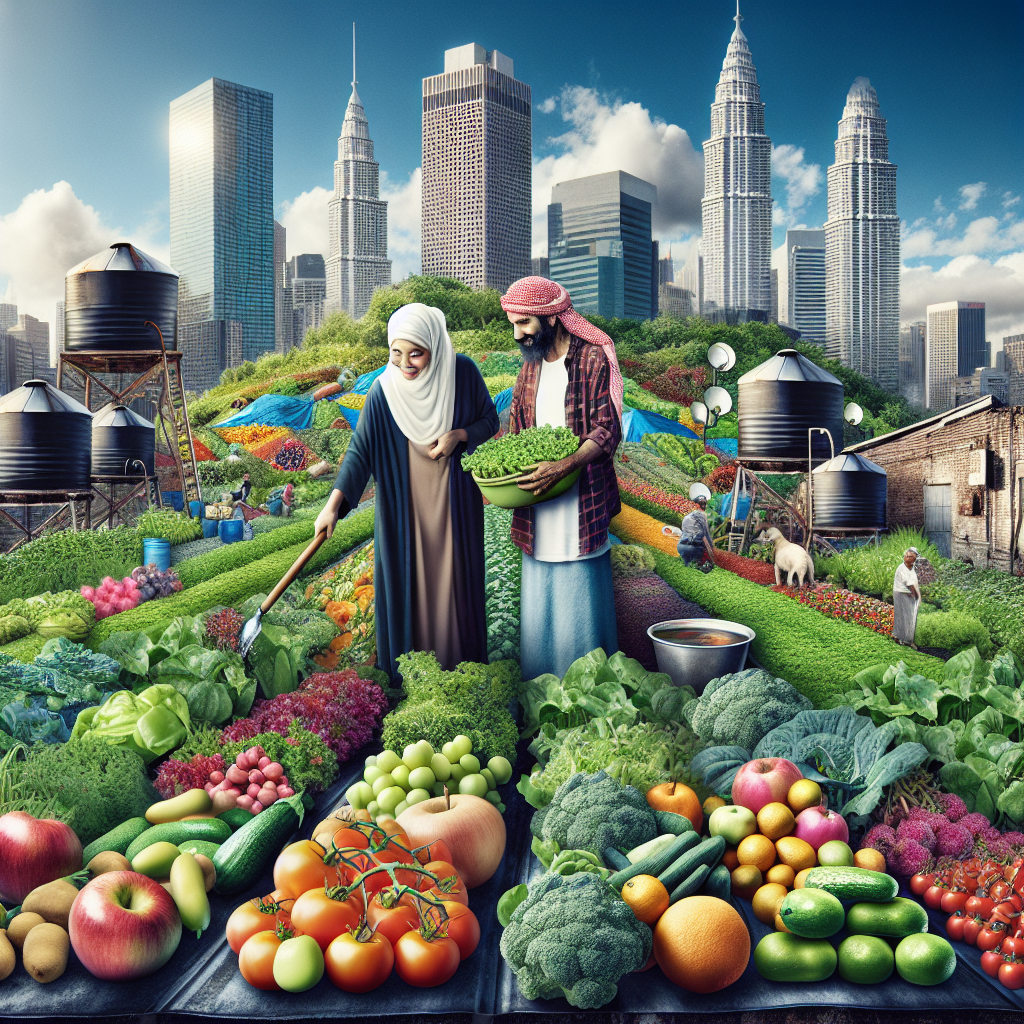
In today’s fast-paced and interconnected world, the issue of food deserts in underserved areas remains a pressing concern. However, there is a glimmer of hope in the form of urban farming, which has emerged as a potential solution to alleviate this problem. By cultivating fresh produce within city limits, urban farming offers a sustainable and community-driven approach to ensuring access to nutritious food for all. Join us as we explore the pivotal role of urban farming in tackling food deserts, and the positive impact it can have on the lives of those living in these underserved areas.

The Definition of Food Deserts
Defining food deserts
Food deserts refer to areas where there is limited access to affordable and nutritious food, typically found in low-income neighborhoods. These communities often lack grocery stores, farmers markets, and other sources of fresh produce and healthy food options. As a result, residents may rely heavily on convenience stores and fast food establishments, leading to a lack of healthy food choices.
Characteristics of food deserts
Food deserts are often characterized by a lack of grocery stores or supermarkets within a certain radius, limited transportation options, and a high concentration of low-income households. These areas may also have a higher prevalence of diet-related diseases like obesity and diabetes due to the lack of access to fresh and nutritious foods.
Impact of food deserts on communities
The presence of food deserts in communities can have a significant impact on the health and well-being of residents. Limited access to fresh fruits, vegetables, and other healthy foods can contribute to the development of chronic health conditions and higher rates of obesity. Additionally, these areas may experience economic disparities, as residents may need to spend a larger portion of their income on unhealthy, processed foods. Food deserts also limit educational opportunities related to nutrition and healthy eating habits, affecting both children and adults in these communities.
Introduction to Urban Farming
Defining urban farming
Urban farming refers to the practice of cultivating and producing food in urban or suburban areas, often in small-scale settings such as community gardens, rooftop gardens, and vacant lots. It aims to bring agriculture closer to densely populated areas, where fresh produce may be scarce due to limited space and resources. Urban farming can take various forms, including vertical farming, aquaponics, and hydroponics.
Types of urban farming
There are several types of urban farming, each with its own unique approach. Community gardens involve residents coming together to cultivate and maintain a shared plot of land, promoting community engagement and education. Rooftop gardens utilize the available space on rooftops of buildings for growing crops, utilizing innovative techniques such as vertical farming to maximize production. Indoor farming, such as hydroponics and aquaponics, involves growing plants indoors without soil, using nutrient-rich water or fish waste to provide necessary nutrients.
Benefits of urban farming
Urban farming offers numerous benefits, particularly for communities affected by food deserts. By bringing agriculture closer to urban areas, it increases food availability and reduces the need for long-distance transportation, making fresh produce more accessible and affordable. Additionally, urban farming can enhance food security, promote sustainable practices, and contribute to a sense of community within neighborhoods. It also provides opportunities for education, job creation, and economic development.

Understanding the Relationship between Urban Farming and Food Deserts
Addressing food access issues
Urban farming plays a crucial role in addressing food access issues in food desert communities. By establishing community gardens and urban farms in these underserved areas, residents gain greater access to fresh, locally grown produce. This helps alleviate the lack of nearby grocery stores and provides an alternative source of nutritious food options.
Increasing availability of fresh produce
One of the main benefits of urban farming in food deserts is the increased availability of fresh produce. By growing fruits, vegetables, and herbs in urban areas, these communities can enjoy a consistent supply of locally sourced, seasonally appropriate, and affordable produce. This helps address the limited access to fresh and healthy food options that residents may face in food desert areas.
Promoting healthy eating habits
Urban farming has the potential to promote healthy eating habits within food desert communities. By providing access to fresh produce and engaging residents in the cultivation process, urban farming initiatives can educate individuals about the importance of a balanced diet and the benefits of consuming fruits and vegetables. This can lead to improved dietary choices and overall healthier lifestyles for community members.
Case Studies on Urban Farming in Alleviating Food Deserts
Example 1: Detroit’s urban farming initiatives
Detroit, often cited as a prominent example of urban farming success, has experienced a significant increase in urban agricultural practices over the years. The city has repurposed vacant lots into community gardens and small-scale farms, increasing access to fresh produce in underserved neighborhoods. Detroit’s urban farming initiatives have not only improved food access but also provided job opportunities and revitalized abandoned areas, contributing to the city’s overall economic and social development.
Example 2: New York City’s urban agriculture projects
In New York City, urban agriculture projects have emerged as a response to the lack of fresh food options in many neighborhoods. Rooftop gardens, indoor hydroponic farms, and community gardens have been established throughout the city, fostering local food production and community engagement. These initiatives have not only increased access to fresh produce but also enhanced environmental sustainability and resilience within the urban landscape.
Example 3: Chicago’s community gardens
Community gardens in Chicago have played a significant role in addressing food access issues and promoting healthy eating habits. Through partnerships with local organizations and government agencies, vacant lots and abandoned spaces have been transformed into thriving gardens, providing residents with fresh produce and educational opportunities. These community gardens have become important gathering places, fostering social connections and empowering community members to take control of their food choices.

The Role of Policy and Government Initiatives
Government support for urban farming
Government support is crucial to the success and expansion of urban farming initiatives in food desert areas. By providing funding, resources, and technical assistance, governments can encourage the establishment and growth of community gardens, rooftop farms, and other urban farming projects. Policies that prioritize urban agriculture and promote land use for farming purposes can also facilitate the development of sustainable food systems in underserved communities.
Incentives for urban farmers
To incentivize urban farming, governments can offer tax benefits, grants, and financial assistance to individuals or organizations engaged in agricultural practices within food deserts. These incentives can help offset the costs of infrastructure, equipment, and seeds, making it financially feasible for urban farmers to establish and maintain their operations. By supporting urban farmers, governments can contribute to increased food security and community resilience.
Regulations and guidelines
While government support is vital, the implementation of regulations and guidelines is also necessary to ensure the safety, quality, and sustainability of urban farming practices. Local governments can establish zoning regulations, building codes, and food safety standards specific to urban farming, ensuring that produce grown in these areas meets necessary health and safety requirements. By providing clear guidelines, governments can promote responsible urban farming practices and protect the well-being of consumers.
Challenges and Limitations of Urban Farming in Food Deserts
Land availability and cost
One of the primary challenges of urban farming in food deserts is the limited availability and high cost of land. Urban areas often have limited vacant spaces suitable for agriculture, making it challenging for individuals or organizations to establish farming operations. Additionally, the high cost of urban land can pose financial barriers for aspiring urban farmers, making it difficult to secure suitable locations for growing crops.
Infrastructure and resources
Urban farming requires adequate infrastructure such as irrigation systems, greenhouse facilities, and the necessary equipment for efficient production. However, the lack of resources and infrastructure in many food desert areas can hinder the establishment and scalability of urban farming initiatives. Limited access to water, electricity, and transportation infrastructure may pose challenges that need to be addressed to ensure the success of urban farming projects.
Community engagement and education
Community engagement and education are essential components of successful urban farming initiatives. However, engaging and educating the local community about the benefits and practices of urban farming can be challenging. It requires building trust, overcoming cultural barriers, and addressing the unique needs and preferences of residents. Investing in community outreach programs and educational initiatives can help overcome these challenges and ensure the long-term success of urban farming in food deserts.

The Social and Economic Benefits of Urban Farming
Job creation and economic development
Urban farming has the potential to create new job opportunities and contribute to economic development within food desert communities. As urban farming initiatives expand, they require a diverse range of skills, including farming, marketing, food processing, and distribution. By employing local residents and supporting local businesses, urban farming can stimulate economic growth and reduce unemployment rates in underserved areas.
Community empowerment and social cohesion
Urban farming projects foster community empowerment and social cohesion by providing residents with a sense of ownership and involvement in the food production process. Community members working together in gardens or farms develop a stronger connection to their neighborhoods and each other, promoting social interactions and collective decision-making. Urban farming can also serve as a catalyst for community-led initiatives and grassroots movements, empowering residents to advocate for change and take control of their food systems.
Education and skill-building opportunities
Urban farming initiatives offer valuable educational opportunities for community members, particularly children and youth. By involving schools and educational institutions in urban farming projects, students can learn about agriculture, nutrition, and environmental sustainability. Urban farming also provides skill-building opportunities in areas such as gardening, entrepreneurship, and food processing, equipping individuals with practical skills that can enhance their employability and promote lifelong learning.
Partnerships and Collaborations in Urban Farming
Public-private partnerships
Public-private partnerships are instrumental in scaling up urban farming initiatives and ensuring their long-term sustainability. By collaborating with local governments, businesses, and nonprofit organizations, urban farmers can access additional resources, funding opportunities, and technical expertise. Public-private partnerships also facilitate knowledge sharing, research, and the development of innovative solutions to address the challenges faced by urban farming projects in food desert areas.
Community organizations and nonprofits
Community organizations and nonprofits play a vital role in supporting and promoting urban farming in food deserts. These organizations often act as catalysts for change, working directly with residents to establish community gardens, offer educational programs, and address social and environmental issues. Through their advocacy and community engagement efforts, nonprofits can mobilize resources, raise awareness, and build networks that strengthen urban farming initiatives and their impact on reducing food deserts.
Support from local businesses
Local businesses can contribute to the success of urban farming projects by providing financial support, resources, or logistical assistance. Restaurants, supermarkets, and food retailers can partner with urban farmers to source locally grown produce, increasing the market demand for fresh, sustainable, and locally sourced food. By supporting urban farming, local businesses can contribute to the economic viability of these initiatives and play a role in addressing food access issues in their communities.

Scaling Up Urban Farming for Greater Impact
Replicating successful models
To maximize the impact of urban farming on alleviating food deserts, it is crucial to replicate successful models and initiatives. By studying and learning from urban farming projects that have proven effective in other communities, stakeholders can identify best practices, address challenges, and implement strategies that align with the specific needs and resources of their own food desert areas. Replication allows for the scalability and widespread adoption of urban farming, creating a more significant, long-lasting impact.
Integration with local food systems
Integrating urban farming with local food systems is essential to ensure the sustainability and resilience of these initiatives. By collaborating with existing food networks, such as farmers markets, community-supported agriculture (CSA) programs, and local food cooperatives, urban farmers can expand their reach and distribution channels. This integration also fosters a stronger connection between urban and rural communities, promoting a more holistic and sustainable approach to food production and consumption.
Investment and funding opportunities
To achieve greater impact, urban farming initiatives in food deserts require continued investment and funding support. Governments, philanthropic organizations, private investors, and crowdfunding platforms can contribute to funding opportunities for urban farmers, providing them with the necessary resources to establish and expand their operations. Utilizing innovative financing models, such as microloans and impact investing, can help bridge the financial gap and generate sustainable funding streams for urban farming projects.
The Future of Urban Farming in Alleviating Food Deserts
Technological advancements
As technology continues to advance, it holds great potential for enhancing and expanding urban farming practices in food deserts. Innovations in vertical farming, hydroponics, and automation can improve yield, reduce resource consumption, and optimize farming processes in limited urban spaces. Smart technologies can also enable real-time monitoring and data-driven decision-making, enhancing the efficiency and productivity of urban farming operations.
Sustainable practices
The future of urban farming lies in sustainable practices that prioritize environmental stewardship and resource conservation. Implementing regenerative agriculture techniques, incorporating renewable energy sources, and minimizing waste are crucial for reducing the ecological footprint of urban farming initiatives. By adopting sustainable practices, urban farmers can contribute to climate change mitigation, biodiversity conservation, and the long-term viability of food production in an urban context.
Policy changes and advocacy
Advocacy and policy changes are necessary to support the future growth and success of urban farming in alleviating food deserts. Governments at all levels must prioritize sustainable agriculture, amend zoning regulations, and develop comprehensive policies that support urban farming. Advocacy efforts from community organizations, nonprofits, and concerned individuals can drive public awareness and political will, ensuring that urban farming remains a priority on the agenda of decision-makers and policymakers.
In conclusion, urban farming plays a crucial role in alleviating food deserts by increasing access to fresh produce, promoting healthy eating habits, and addressing food access issues in underserved areas. Through partnerships, government support, and community engagement, urban farming initiatives can create social, economic, and environmental benefits, while also empowering communities to take control of their food systems. With continued investment, policy changes, and technological advancements, urban farming has the potential to drive significant change and improve the overall well-being of food desert communities in the future.







